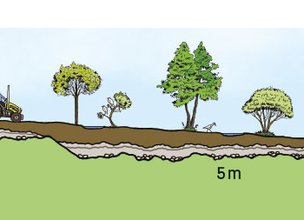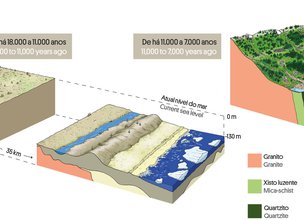In the last 450 thousand years, there have been four maximum glaciers in which the slopes and plateaus of this area were covered with snow. During the deglaciation that preceded each interglacial that succeeded it, torrents of blocks, grains, mud and soil were generated.
As a result of the last deglaciation, which took place between 18,000 to 11,000 years ago, especially after that period, layers of those sediments, up to 3 m thick, covered the ancestral coastal platforms levelling a coastal platform occupied by fields with a weak slant from the foothill of the Sta Luzia Mountain to the current coastline.
Today, the fields are fertile and impermeable, fruit of the fine sediments with organic matter deposited there during the last deglaciation, covering and hiding the ancestral coastal platforms still visible in the Local Natural Monument Cemetery of Ancient Beaches of Alcantilado de Montedor. The coastal platform, a soft ramp towards the Atlantic allows riparian vegetation like the willows (Salix alba) to be fixed very close to the surf zone and to create ponds where birds like the cattle egret (Bubulcus ibis) feed.
References:
Carvalhido (2012). O Litoral Norte de Portugal (Minho-Neiva): evolução paleoambiental quaternária e proposta de conservação do património geomorfológico. Tese de Doutoramento, Universidade do Minho, 564 p.
Carvalhido, R.; Pereira, D. & Cunha, P. (2014a) – Depósitos costeiros quaternários do noroeste de Portugal (Minho - Neiva): caracterização datação e interpretação paleoambiental. Comunicações Geológicas (2014) 101, Especial II, 605–609.
Carvalhido, R.; Brilha, J. & Pereira, D. (2014b) – Monumentos Naturais Locais de Viana do Castelo: processo de classificação e estratégias de valorização. Comunicações Geológicas (2014) 101, Especial III, 1219–1223.
Carvalhido, R.; Pereira, D; Cunha, P.; Buylaert, J. & Murray, A. (2014c) Characterization and dating of coastal deposits of NW Portugal (Minho-Neiva area): a record of climate, eustasy and crustal uplift during the Quaternary. Quat Int, 328-329: 94–106
Carvalhido, Ricardo (2014d). Processo de classificação dos 5 Monumentos Naturais Locais de Viana do Castelo. Memória Descritiva. Câmara Municipal de Viana do Castelo.
Carvalhido, Ricardo (2018). Livro de Pedra, Monumentos Naturais Locais de Viana do Castelo – Catálogo. Câmara Municipal de Viana do Castelo, 2ª edição.
In the last 450 thousand years, there have been four maximum glaciers in which the slopes and plateaus of this area were covered with snow. During the deglaciation that preceded each interglacial that succeeded it, torrents of blocks, grains, mud and soil were generated.
As a result of the last deglaciation, which took place between 18,000 to 11,000 years ago, especially after that period, layers of those sediments, up to 3 m thick, covered the ancestral coastal platforms levelling a coastal platform occupied by fields with a weak slant from the foothill of the Sta Luzia Mountain to the current coastline.
Today, the fields are fertile and impermeable, fruit of the fine sediments with organic matter deposited there during the last deglaciation, covering and hiding the ancestral coastal platforms still visible in the Local Natural Monument Cemetery of Ancient Beaches of Alcantilado de Montedor. The coastal platform, a soft ramp towards the Atlantic allows riparian vegetation like the willows (Salix alba) to be fixed very close to the surf zone and to create ponds where birds like the cattle egret (Bubulcus ibis) feed.
References:
Carvalhido (2012). O Litoral Norte de Portugal (Minho-Neiva): evolução paleoambiental quaternária e proposta de conservação do património geomorfológico. Tese de Doutoramento, Universidade do Minho, 564 p.
Carvalhido, R.; Pereira, D. & Cunha, P. (2014a) – Depósitos costeiros quaternários do noroeste de Portugal (Minho - Neiva): caracterização datação e interpretação paleoambiental. Comunicações Geológicas (2014) 101, Especial II, 605–609.
Carvalhido, R.; Brilha, J. & Pereira, D. (2014b) – Monumentos Naturais Locais de Viana do Castelo: processo de classificação e estratégias de valorização. Comunicações Geológicas (2014) 101, Especial III, 1219–1223.
Carvalhido, R.; Pereira, D; Cunha, P.; Buylaert, J. & Murray, A. (2014c) Characterization and dating of coastal deposits of NW Portugal (Minho-Neiva area): a record of climate, eustasy and crustal uplift during the Quaternary. Quat Int, 328-329: 94–106
Carvalhido, Ricardo (2014d). Processo de classificação dos 5 Monumentos Naturais Locais de Viana do Castelo. Memória Descritiva. Câmara Municipal de Viana do Castelo.
Carvalhido, Ricardo (2018). Livro de Pedra, Monumentos Naturais Locais de Viana do Castelo – Catálogo. Câmara Municipal de Viana do Castelo, 2ª edição.

Stratigraphic model of coastal platforms

Evolution of the coastal platform
Location
Canto Marinho
Coordinates
Lat: 41.730568
Long: -8.871299
Hello little one!
I'm Piquinhos and I can help you learn more about the Geopark!
Technical details
Coastal Platform
Accordingly to (Carvalhido, 2012, 2014a,b,c,d, Carvalhido, 2018) the LNM Canto Marinho area is of great interest for the understanding of global climatic and oceanographic phenomena at a local scale where it is possible to observe the coastal platform - ramp with a gentle slope towards the ocean - covered by sediments, up to 3 m thick, from the successive episodes of deglaciation that occurred in the last 450 thousand years.
16 sedimentary units with varied sedimentological characteristics were identified, studied analytically through 7 fixed tests: granulometric test, morphoscopic classification, rolling index (morphometry), mineralogy of the light sandy fraction, organic matter content, carbonate content and pH, and radiometric dating by 14C and OSL that clarified the depositional models, the sedimentary facies that were defined and the ages, between 330 ka (MIS9) and 13 ka (MIS1) (Carvalhido, 2012)
These sediments cover and hide the ancestral coastal platforms and rocks under the coastal platform, forming the veins whose origin is due to the waterproofing, moisture and nutrients provided.
References and scientific articles
Carvalhido (2012). O Litoral Norte de Portugal (Minho-Neiva): evolução paleoambiental quaternária e proposta de conservação do património geomorfológico. Tese de Doutoramento, Universidade do Minho, 564 p.
Carvalhido, R.; Pereira, D. & Cunha, P. (2014a) – Depósitos costeiros quaternários do noroeste de Portugal (Minho - Neiva): caracterização datação e interpretação paleoambiental. Comunicações Geológicas (2014) 101, Especial II, 605–609.
Carvalhido, R.; Brilha, J. & Pereira, D. (2014b) – Monumentos Naturais Locais de Viana do Castelo: processo de classificação e estratégias de valorização. Comunicações Geológicas (2014) 101, Especial III, 1219–1223.
Carvalhido, R.; Pereira, D; Cunha, P.; Buylaert, J. & Murray, A. (2014c) Characterization and dating of coastal deposits of NW Portugal (Minho-Neiva area): a record of climate, eustasy and crustal uplift during the Quaternary. Quat Int, 328-329: 94–106
Carvalhido, Ricardo (2014d). Processo de classificação dos 5 Monumentos Naturais Locais de Viana do Castelo. Memória Descritiva. Câmara Municipal de Viana do Castelo.
Carvalhido, Ricardo (2018). Livro de Pedra, Monumentos Naturais Locais de Viana do Castelo – Catálogo. Câmara Municipal de Viana do Castelo, 2ª edição.
Stratigraphic model of coastal platforms
Evolution of the coastal platform
Child Mode
Discover the geopark in a simpler format, aimed at the little ones.
Clique ENTER para pesquisar ou ESC para sair